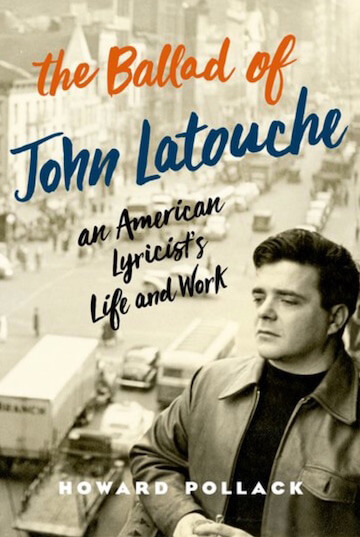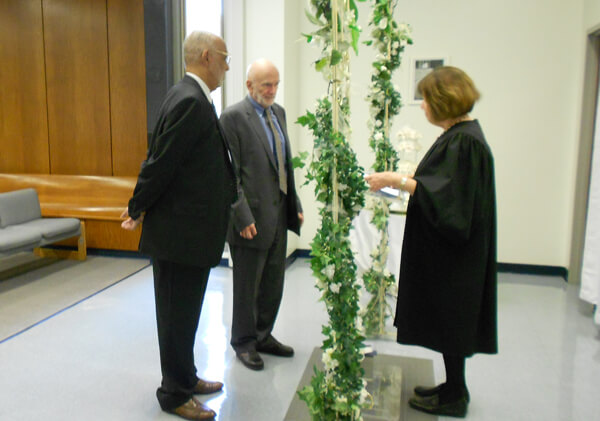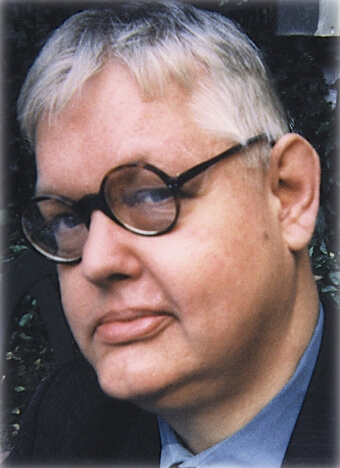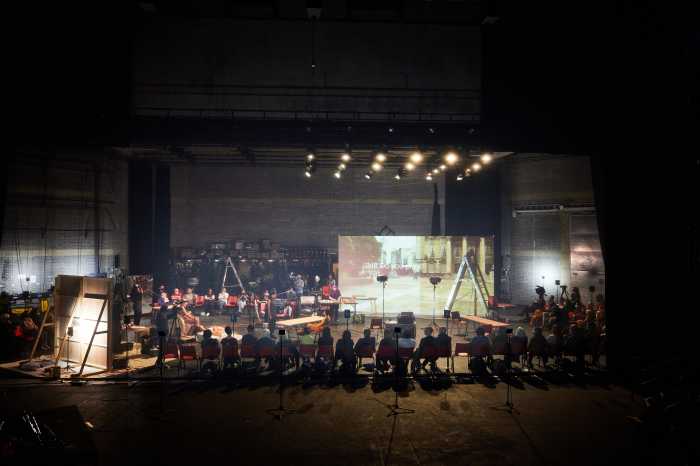OXFORD UNIVERSITY PRESS
John Latouche was just 41 years old in 1956 when he was felled by a massive coronary. But according to his friend composer Ned Rorem, “Since he had lived three lives in one, wasn’t he really 123 years old when he disappeared forever?”
Howard Pollack’s “The Ballad of John Latouche; An American Lyricist’s Life and Work” proves that while the lyricist and librettist may be physically absent, his work, which includes the musicals “Cabin in the Sky,” “The Golden Apple,” and “Candide” and the opera “The Ballad of Baby Doe,” makes him present forever. In fact, by the time one has finished reading this massively detailed biography (far more complex than “Marc Blitzstein: His Life, His Work, His World,” Pollack’s far from merely admirable study of Latouche’s contemporary and collaborator), Rorem’s “three lives” estimation may seem a tad modest.
“I see that my life is like a succession of dark rooms through which I wander with outstretched arms.” So wrote Latouche in a journal from his high school years. A rather mature turn of phrase for a teenager, wouldn’t you say? But then one of his future collaborators, Billy Strayhorn, wrote the classic “Lush Life,” with its indelible first line “I used to visit all the very gay places,” in his teens, too. Both became brilliant gay adults.
Howard Pollack’s masterful biography of an American musical theater giant
But Latouche was most striking for the way he made his considerable artistic ambitions plain early on. For when a teacher admonished him for his indifference to a pop quiz, refusing to put down his copy of “The Well of Loneliness,” Latouche snapped, “This looks too important to stop reading for a test.”
At this point settled in Richmond, Virginia, the adolescent Latouche quickly became involved in community theater. A polymath functioning at a furious pace, he showed interest in everything from hypnotism to the occult to the vagaries of American folk music. In fact, at the time of his death, Carson McCullers noted, “John was so modest few people realized he was one of the most profound folk musicians in this country.”
That such expertise would play an important role in his musical endeavors is clear, particularly in relation to “Cabin in the Sky” (1940). His first Broadway success, with music by Vernon Duke, it was a fable of sin and redemption with an all-black cast headed by Ethel Waters, Rex Ingram, and dancer Katherine Dunham. Its show-stopping hit “Taking a Chance on Love” became an instant standard, beloved to this very day.
It was the first of three musicals Latouche and Duke collaborated on. The other two were “Banjo Eyes” (1941) — a musicalization of “Three Men On a Horse” designed for its star Eddie Cantor, that produced “Not a Care in the World” (with its immortal lyric “I’m as gay as a Disney Cow”) — and the less successful “The Lady Comes Across” (1942), which offered “You Took Me By Surprise” and a cast that included Gower Champion and Ronny Graham. But Latouche’s career was at this point off and running almost as fast and furiously as he was.
A heavy drinker and controlled substance indulger (Pollack recounts how Latouche and Burroughs acolyte Brion Gysin would go on drug “binges” together), he was also a workaholic who seems to have seldom slept. Still, he was cheerful by temperament. Jerry Stiller, one of “The Golden Apple”’s original cast members, recalls how the show’s creator “sparked up the place with his presence.” So while McCullers’ assessment of his personality may be correct as far as she’s concerned, few would describe Touche (as his intimates called him) as “modest.” What he had was enormous charm and relentless drive. Casting his social net far and wide over the course of his life he came to know such diverse notables as Marlene Dietrich, Natacha Rambova, Frank O’Hara, Gore Vidal, Charles Henri Ford, Anaïs Nin, Dr. Max Jacobson (of the infamous vitamins and speed injections that boosted everyone from Judy Garland to JFK to Edie Sedgwick), novelist Dawn Powell, and freelance wit Alexander King.
In addition to his shows, Latouche devised hilarious original cabaret routines for such performers as Spivey LeVoe, Charlotte Rae, and Hope Emerson, which they performed at chic New York nightspots. One written for Emerson, entitled “Simeone Simeone Lapin,” recounts the life of a transgender rabbit. And this quite logically provides an opening for peering into Latouche’s queer profile — which is considerable and complex.
A bohemian to his core, Latouche thrived in an artistic zeitgeist of the last century that was quite open to sexual non-conformity. But he wasn’t simply a gay man. Latouche, like Proust, was very much enamored of lesbians. Thomas Mann’s daughter, Erika, and her lover, actress Therese Giehse, were both Latouche pals. He was exceptionally friendly with Jane Auer — introducing her to Paul Bowles, whose name she took in art as well as life. Latouche was the model for the character of “Arnold” in Jane’s famous (and alas only) novel “Two Serious Ladies.” Paul (whom Latouche was attracted to but probably never scored with, Bowles being very picky in his same-sex en- tanglements) said his friend “collected German and Central European refugees the way someone might collect tropical fish.”
But he also collected lesbians — going so far to marry one, Theodora Griffis, an upper class woman with highbrow pretensions, who none other than Patricia Highsmith described as “extremely masculine.” Latouche’s decision to marry her was impulsive — like so much in his life — and it is quite likely that they never actually much lived together, he being busy with his work and a romantic life that often found him juggling two male lovers at a time (writer Bob Faulkner and painter Jimmy Ernst early on, and college student Harry Martin and poet Kenward Elmslie at the close). Dietrich once caught Latouche in bed with her erstwhile boytoy, Yul Brynner. No, it didn’t end their friendship.
Gore Vidal, seemingly impervious to romance, was far from indifferent to Latouche’s elfin charms. But the course of their affair, such as it was, didn’t get in the way of Vidal’s intense admiration for Latouche’s art. His roman a clef of New York in the late 1940s and early ‘50s is entitled “The Golden Age,” in honor of “The Golden Apple” — Latouche’s most important work, whose premiere Vidal claims brought down the curtain on what he saw as America’s richest artistic period.
Needless to say, Latouche didn’t come to this watershed overnight. Its seeds were sown in the Federal Theater Project of the late 1930s — principally in the wake of the project’s most infamous achievement, Blitzstein’s socialist musical “The Cradle Will Rock” (1937). Latouche shared Blitzstein’s left-wing sympathies but was at some remove from the Communist Party itself, in which Kenward Elmslie said Latouche “would have lasted for about five minutes.” Still, he made a political mark artistically with the post-“Cradle” Federal Theater production “Sing For Your Supper” (1939), with the show’s climactic number “Ballad For Americans.” Created with music by leftist scribe Earl Robinson, its a song and spoken word salute to the USA highlighted by the lines “They fought so this would be a country were every man was free and equal,” and “For I have always believed it / And I believe it now / And now you know who I am./ ( Who are you?) / America! America!” In other words, the song was patriotic, with a leftist slant. But not so much to prevent either Paul Robeson or Bing Crosby from making popular recordings of it.
After this came “Beggar’s Holiday” (1946-7), Latouche’s first musical, for which he wrote the libretto as well as the lyrics. An adaptation of John Gay’s “The Beggar’s Opera” (most famously adapted by Brecht and Weill as “The Threepenny Opera”), “Beggar’s Holiday”’s music was provided by Billy Strayhorn — though credited to Duke Ellington. Latouche had written with Strayhorn before, providing lyrics to the tune “Daydream.” The musical starred Alfred Drake as “Macheath” and featured Libby Holman, Zero Mostel, and Avon Long, under the direction of Nicholas Ray. “The Beggar’s Holiday” produced the cheeky “I’ve Got Me” — the best tribute to narcissism ever sung. But while well-regarded by most critics, the show was not a hit.
Then came “Ballet Ballads” (1948). Latouche’s first collaboration with composer Jerome Moross, it wasn’t a conventional book musical but rather a series of mini-musicals — all variations of what was known as “Americana.” The four “Ballads” were “Susanna and the Elders.” “Riding Hood Revisited,” “Willie the Weeper,” and “The Eccentricities of Davy Crockett.” While he couldn’t really sing or carry much of a tune at all, Latouche devised some “dummy” melodies to show Moross what he was looking for. “The melodies I invented give the individual lyrics a unified dramatic flow,” he explained. This “flow” made for a hit leading to the far more ambitious “The Golden Apple” (1954).
Nothing less than a retelling of “The Iliad” and “The Odyssey,” Latouche put ancient Greece aside for America in the wake of the Spanish-American War. Set in a town called “Angel’s Roost,” part of Mount Olympus in Washington State, it recounts how the town’s most popular lass, Helen, is wooed by a traveling salesman named Paris who spirits her off in a balloon to the big city of “Rhododendron” — Latouche’s stand-in for Troy. Besides Paris and Helen, Ulysses, Penelope, and Hector remain as names for their Homeric counterparts but others are townspeople called “Miss Minerva,” “Lovey Mars,” and “Mrs. Juniper,” plus the local seer “Old Mother Hare” who creates the Golden Apple of the show’s title as the prize in a baking contest that Paris judges. He awards it to “Lovey Mars” just before spiriting Helen away — which arouses the townspeople to put what the Second Amendment calls a “well regulated militia” together to go off and bring her back.
Ulysses is the leader of this crew and bids his wife Penelope goodbye, claiming that duty to his fellow man requires he lead this venture. For her part, Penelope says men “blame it all on duty” — in other words, rescuing Helen is simply a pretext for feeding men’s lust for adventure. In any event, Helen, who’s having a fine time in the city (her “My Picture in the Papers” number reminiscent of Latouche’s cabaret work), takes a back seat in the proceedings to the action where Ulysses and his men are destroyed in one way or another. While in the end order is restored and Ulysses and Penelope are reunited, what’s most memorable about the show is the sparkling irreverence of individual numbers and the novel ways they are linked together. In other words, it’s a long way from Rodgers and Hammerstein and for many a presage of Sondheim — though Sondheim himself doesn’t agree.
“Our styles couldn’t be more different,” the creator of “Sweeney Todd” is quoted as saying. Though he grants that Latouche had “a large vision of what musical theater could be,”’ his lyrics were “static and self-consciously poetic despite some occasionally funny lines,” Sondheim says. One can see, to an extent, what Sondheim means in that Latouche was always specific in the comic effect he wanted to create through his lyrics (think of “In My Old Virginia Home (on the River Nile)” from “Cabin in the Sky” with “stead of Mammys we’ll hear Mummies softly hum”), with little room for the emotional ambivalence that’s Sondheim’s stock in trade. A number like “The Golden Apple’”s big hit, “Lazy Afternoon,” is unimaginable for Sondheim in it bright straightforwardness. But whether God (as Sondheim is sometimes referred to) likes it or not, “The Golden Apple” is a musical comedy touchstone that looks forward to that form’s further evolution.
Opening at the Off-Broadway Phoenix Theatre, “The Golden Apple” won Best Musical of 1954 from the New York drama critics and moved to Broadway for a time. While it only ran for a total of 174 performances, the show toured in several cities. Frank O’Hara set the typescript of the published book of the show, which has periodically had limited revivals over the years. But the most complete came in 2015, when the Lyric Stage in Texas not only staged it but made the first complete recording. The original cast album released in 1955 can only be said to contain highlights of this musically massive undertaking, every word of which is sung like an opera — or a Jacques Demy movie.
Because of his leftist sympathies, Latouche was considered a “fellow traveller” to Communism and in 1950 was listed in “Red Channels” — the notorious literal blacklist of those in show business who because of their left-wing affiliations were deemed unworthy of employment. This kept his songs off the radio and him out of Hollywood. But it didn’t stop him from working. Nothing could. According to his friend Lord Kinross, Latouche “lived at a turbulent pitch such as few human beings can sustain for long.” And that’s a perfect description of his last years, which find him writing the lyrics for most of the songs in Leonard Bernstein’s “Candide,” a show starring Carol Channing called “The Vamp,” and the opera with music by Douglas Moore, “The Ballad of Baby Doe,” virtually all at the same time.
Of this trio, the only one he lived to see was “The Vamp” (1955), a Broadway musical that began as a variation on Saint-Saëns’ “Samson and Delilah, with a score by musicologist James Mundy who had never written anything like it before. Ronny Graham and Mel Brooks worked on the book, which gradually took the form of a satire of Hollywood in the 1930s on the order of “Singin’ in the Rain.” The cast included the blacklisted actor Will Geer and muscleman Steve Reeves. But it was Channing’s show, winning her good personal notices despite its brief run.
“Candide” found Latouche clashing with Bernstein, resulting in some of the songs sporting his lyrics and others those of poet Richard Wilbur. “The Ballad of Baby Doe” was a much happier affair. Working with composer Moore, Latouche fashioned a libretto involving an actual historical figure — mining magnate Horace Tabor. Into the lives of Tabor and his wife comes a mysterious woman — “Baby Doe” — a singer who encourages him to build an opera house for her. In short, it’s an opera about opera. Created for the newly formed New York City Opera, the show’s title role went to a newcomer, Beverly Sills. Its success made the company famous and Sills a star — with her taking over the management of the company in her later years.
Latouche would doubtless loved to have seen “The Ballad of Baby Doe.” But one evening in 1956 he complained to lover Harry Martin, in whose house he was living (alternating with the abode of his other lover, Kenward Elmslie), that he was having chest pains and was going to bed. Martin found him dead the next morning, clutching a medical textbook turned to a passage describing the very heart attack that killed him.
The American musical theater lost a genius and a whole world of artists and acolytes lost a man they deeply loved. In “A Step Away From Them,” a poem from 1964, Frank O’Hara wrote:
“First
Bunny died, then John Latouche,
then Jackson Pollock. But is the
earth as full as life was full, of them?”
“Bunny” was poet and verse scholar V.R. Lang, known to a select few. Latouche and Pollack were known by one and all. And after his death in 1966, so was Frank O’Hara. But the last word on all of this is best heard from Latouche himself via “The Willow Song” — the most famous aria in “The Ballad of Baby Doe”:
“Ah!
Willow, where we met together
Willow, when our love was new
Willow, if he once
should be returning
Pray tell him I am weeping too.
“So far from each other
While the days pass
In their emptiness away.
Oh my love, must it be forever
Never once again
To meet as on that day?
And never rediscover
The way of telling
The way of knowing
All our hearts would say.
“Gone are the ways of pleasure
Gone are the friends I had of yore
Only the recollection fatal
Of the word that was spoken:
Nevermore.
“Oh, willow, where we met together
Willow, when our love was new
Willow, if he once
should be returning
Pray tell him I am weeping too.
“Ah!”




































